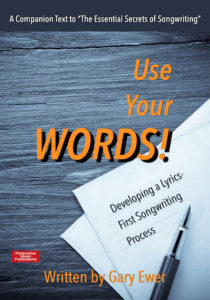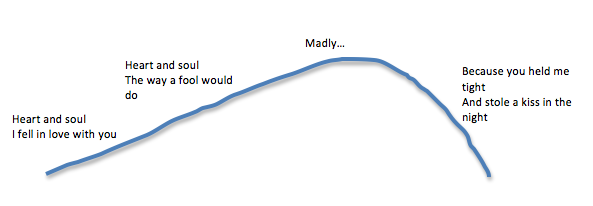“Heart and Soul“, that popular song that so many people like to plunk out mindlessly on piano, is a lot older than many realize. It was written in 1938 — 80 years ago! — by American songwriters Hoagy Carmichael and Frank Loesser.
If you look up “infectious” in a music dictionary, don’t be too surprised to see “Heart and Soul” used as part of the definition. If you’re the kind of songwriter looking to create melodies that are similarly enticing, it’s worth the time spent to figure out what’s so appealing about it.
 Trying to get a handle on writing song lyrics? Discover the benefits of making a lyrics-first method your new go-to process with”Use Your Words! Developing a Lyrics-First Songwriting Process. It’s FREE right now when you purchase the 10-eBook Bundle.
Trying to get a handle on writing song lyrics? Discover the benefits of making a lyrics-first method your new go-to process with”Use Your Words! Developing a Lyrics-First Songwriting Process. It’s FREE right now when you purchase the 10-eBook Bundle.
The song is in ABA format: a first melody (A) that starts on the tonic note, moves upward to the dominant note (with a little bump up to the note just above the dominant), before moving down again to cadence on the lower tonic. If you smooth it all out, you’re looking at a melody map that’s a bit like an inverted-U, starting low, moving high, then finishing low:

The B-section of the song (“Oh, but your lips were thrilling…”) practically nobody knows. It’s that opening A-section melody that everyone loves (or, because of its earworm quality, loves to hate).
The relevant question regarding this song to you as a songwriter is this: why do people love playing it? What is it about “Heart and Soul” that makes it irresistible? And can you apply anything you learn to your own songs?
I think there is much that’s attractive about the song, but these three qualities stand out:
- The inverted-U (up-and-down) shape of the melody builds musical energy in a very natural way.
- The undulating “boom-ba-chick-a boom-ba-chick-a” rhythm underneath is easy and fun to play, and meshes perfectly with the rhythm of the melody.
- The lyrics drip with gooey loveliness.
The Power of the Inverted-U
The inverted-U (or similarly the inverted-V) is a common shape in practically all genres and in all eras of music when it comes to 3-part songs, and I think that’s the aspect of “Heart and Soul” that’s the most enticing. Not all songs will show the measured and precise shape that this one does. “It’s Only Make Believe” (Jack Nance, Conway Twitty) shows a similar approach — starting low, then gradually and predictably moving upward before finally ending lower.
You see the shape more creatively expressed in songs like “Hey Jude” (Lennon & McCartney), where the journey upward and downward has considerably more bumps and redirections before the eventual ending note. But the shape is there, and it works.
For those of you trying your hand at the melody-first songwriting process, you’ll find that the inverted-U will serve you well especially in songs that don’t make use of a chorus.
The precise method will be different for every song you write, but here is the basic outline:
- Start the melody somewhere low in your vocal range — a low tonic or low dominant is especially common.
- Move the melody upward, often by sequencing your melody (i.e., repeating a similar melodic idea but starting on a higher note, as you hear in “Heart and Soul,” the second phrase of which is a repeat of the first phrase, but starting 3 notes higher.
- Find a spot for your melody’s highest note somewhere in the third phrase, or perhaps at the start of the 4th phrase.
- End your melody on a low note, usually a tonic note.
That gives you the classic inverted-U that is so common in verse-only (or verse-refrain or verse-bridge) songs.
Constructed that way, you’ll hopefully enjoy all the success of “Heart and Soul!”
 Written by Gary Ewer. Follow Gary on Twitter.
Written by Gary Ewer. Follow Gary on Twitter.
 “The Essential Secrets of Songwriting” 10-eBook bundle includes several chord progression eBooks, including “Chord Progression Formulas”. Learn how to create chord progressions within seconds using these formulas.
“The Essential Secrets of Songwriting” 10-eBook bundle includes several chord progression eBooks, including “Chord Progression Formulas”. Learn how to create chord progressions within seconds using these formulas.










